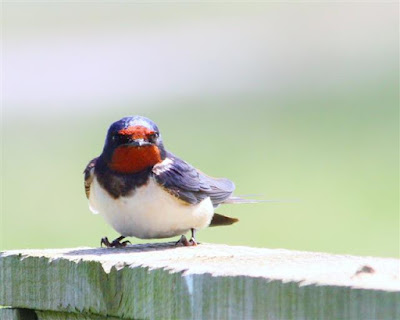No holiday to the North Norfolk coast would be complete without spending some time at
Titchwell RSPB Reserve so here are some images from our two seperate visits on day 3 when we met up with our friends Jean and Tony, also on holiday but staying further east near Wells, and day 6 when Anita and I dropped in for a late afternoon stroll. Once again there was a very fresh and breezy north-easterly wind and rain on the radar so we had to wrap up and protect ourselves from the elements in the middle of June!
The resident friendly Robin very quickly perched on the car wing mirror to see if we had any scaps.
My friend Keith at holdingmoments had this chap eating out of his hand earlier this year. As we headed out onto the reserve we had our first sightings of Marsh Harriers quartering over the reed beds plus a Red-Crested Pochard was located on one of the reed fringed pools with Teal, Gadwall, and Tufties.

Plenty of activity overhead with Swifts, Swallows and House Martins. Reed Buntings occasionally perched on the swaying reeds. From the hide Tony and I scoped out the distant ducks and waders including Gadwall, Shoveller, Shelduck, Pochard, Mute Swan, Greylag Geese, Cormorant, Little Egret, Knot, Black-tailed Godwits, Redshank, Greenshank, Ringed Plover, Lapwing, Little Gull, Black-headed Gulls, Lesser Black-backed Gulls, Herring Gulls, Common and Little Terns. Elsewhere we also saw Kestrel, Sparrowhawk, Linnet, Meadow Pipits, Starlings, Wigeon, Grey Heron, Pied Wagtail, Cetti's Warbler (heard only) and fleeting glimpses of a Bearded Tits flying into the reeds.
The main activity alongside the path were young Sedge Warblers perched precariously in the reed bed constantly begging for food from their overworked parents.
As expected there were lots of (Pied) Avocets on the freshwater lagoons. A very windy walk out onto the beach produced Turnstone, Bar-tailed Godwit, Dunlin and Oystercatchers feeding along the tide line. With a rain front approaching and Tony getting hungry it was soon time for us to head back towards the Reserve Centre for much needed refreshments.
As we crossed the boardwalk a pair of Skylarks noisily alighted on the handrail allowing me a few quick shots.
Check out the length of those hind claws!
Another birder stopped us and asked if we were any good with wader ID to which Tony immediately responded by pointing at me.....no pressure I thought! Through his scope I located the distant objective....larger than a Dunlin; showed large primary projection; a very slight decurved bill and the heavily streaked breastband that is sharply demarcated against the white unmarked underbelly...a PECTORAL Sandpiper. I reported this sighting at the Reserve Centre and was immeditely referred to the resident warden who suggested that it might be the same bird that was recorded at Frampton Marshes on the other side of The Wash and definitely an unusual record for Titchwell in the spring. (Usually only seen during Autumn return migration). Just a pity I couldn't get a photo as the bird didn't stop long after feeding and I think we were the only 3 people to spot this individual.

The final encounter on our second visit was this Pheasant eagerly waiting for help from the Pigeon to cadge a titbit that may fall out of the feeder.
N.B. If anyone is thinking of visiting Titchwell later this year the path to the sea will be closed from August to October as work on the Coastal Change Project continues...not sure what effect this will have on all the returning migrants and wintering species that use this stretch of important marsh......FAB.


















































